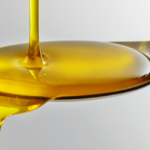Another Excerpt From “Your Body Needs An Oil Change”

As you may know, I've been hard at work finishing my latest book, “Your Body Needs An Oil Change”, over this past year. I'm very excited to tell you that I'm getting closer to handing it over to the publisher.
Below is an excerpt on how I came to creating ‘Oils Made With Health In Mind'.
I hope you enjoy it. If you have any questions, feel free to send them to me.
Can We Make Oils with Health in Mind?
A new thought came to me: We should make oils with health in mind! After all my reading and thinking, my practical conclusion was that oils will support health only if they are made with much greater care than they were currently getting. I began to conceptualize how that could be done.
My reasoning went like this: When we give good oils care, they retain their health benefits. Then, good things unfold for health when we eat enough of them. If we protect them, they’ll protect our body. When we don’t make a processing mess at the front end, we won’t need a chemical feast to clean up that mess at the back end and make another mess. If we supply the body with optimum quantities of good oils, the amount that life requires of these essential building blocks for optimum body construction and function, they will play their role toward optimum health. When we set higher standards for oil production, we end up with better oils. Better oils will have more positive effects on health than damaged oils.
Can we design or devise a better way to make oils? Sometimes, I’d think, “Who do I think I am, believing I could do a better job than a mega industry with an annual turnover of more than one hundred billion (sixty billion at that time) dollars? Can a little upstart guy like me accomplish something like this? If it were important, would they not have done it?”
But there it was. It wasn’t about little or big. It was a matter of giving oils more care. It seemed to me that I could invent a way to make oils better than they were being made.
In 1983, I put my design concepts on paper, and with the help of engineers, my team and I later converted my ideas for making oils with health in mind into machinery that makes such oils.
What is the secret sauce? Care. We give oils the care they need to retain their health benefits, by protecting the highly sensitive oil molecules from being damaged by light, oxygen, heat, minerals (metals), water, and harsh chemical treatments. It was a simple solution, but one that did require intent toward health, as well as care in its execution.
My Choice
The choice I saw for making oils with health in mind began with some questions, “Why not start with organically grown seeds and nuts?” Then we would not have to overheat the oil to try to boil off the pesticides since the oil would be free of them, PCBs, dioxins, or other industrial chemicals. I thought, “Why not protect oils from damage done by light, oxygen, and heat?” That way, processing would not damage them. They would not contain damaged oil molecules.
I thought, “Why not omit using harsh chemicals?” That way, there would be no toxic chemical residues in the oil, and no damage would be done to the oil molecules by them.
I thought, “Why not keep the oils unrefined?” That way, the oils would still contain all the natural, oil-soluble ingredients present, some of which have major health benefits. That should be an improvement in health-related oil quality.
And finally, I thought, “Why not keep the oil in its natural state?” There would be nothing in it that could interference with body functions. It would take more effort, but it would pay off in better health.
Next, I developed a method for doing all this. It was not difficult for me because I understood the issues involved. I could finally use my background in science, biological sciences, biochemistry, and genetics to do something with practical value.
Oils made with health in mind would end up getting a lot of special care during the pressing, filtering, and filling processes used to make them.
A Book on Oils
It didn’t take long before I became impatient with the pace of my research, and the writing that was coming from what I learned.
My hope was to write a book on what I was learning about fats and oils, because I thought such a book could be helpful to other people in their quest for better health. After a conversation with my mother, in which I expressed my interest in reading and writing full-time, she invited me to move (back) in with her. She would supply room and board. I would give health my full-time attention.
Forty-one years old, I moved back in with mom in 1983 but it felt right to do so and turned out to be good for both her and me. The trade-off was that my mom had a stroke about three years later, and it was helpful to her for me to be there to assist her in small ways and provide some confidence in her situation.
When I began writing, I estimated that it would take about six months to get the reading and research on fats and oils done, and the book written. That guess turned out to be overly optimistic. It took almost six years.
At Mom’s place, with a calm and focused passion, I continued to reconcile contradictions in research, type notes and thoughts I had written down from library research journals (yes, before the internet), seek to bring structure to the topic of fats and oils, wait for the flow of writing to come, edit messy sentences, and throw out manuscripts because I realized that I would not buy the book I was writing, and knew that I had to start again from scratch to write one I would buy. On my third try at it, the writing began to flow, and fifty-four of fifty-nine chapters almost wrote themselves, one after another, without interruption other than food, hygiene, and sleep. Over the five years I spent reading the research and writing the book, I did occasionally have doubts about whether I could do what no one else had, in a field in which I had not been formally trained. My friends were drinking and partying, and a few times I felt tempted to join them, hindering my passion for making oils with health in mind. Each time, though, something would remind me that I was on the right track, re-inspiring me to refocus and continue.
Confidence in my ability to get it done carried me most of the time. Inspired in my core, I was on fire for what was possible. Living and operating in this state of being, the work meant more to me than either getting credit or making money. I’ve read similar reports from some of the most successful people during their pioneering of innovative years.
Flax Seed’s Origin Story
This was also a chance to put my method for making oils with health in mind into practice. The most sensitive oil would need the most exacting processing method. If we could make the oil containing the most omega-3 by the method I had devised, making any other oil thereafter would be a piece of cake. Flax, the super-rich source of omega-3, would be my first oil; the one to cut my teeth on. At that time, flax seed was also called linseed. A refined, bleached, deodorized (RBD) version of oil made from it, called linseed oil, partially damaged by the industrial process used to make it, was used to paint furniture because its reaction with light and oxygen cross-linked its molecules into a protective coat on furniture. Sometimes, linseed oil was boiled with lead to make the oil cross-linking even quicker and more effective. It made furniture smell characteristically rancid for months or even years, but it did provide protection for wood surfaces.
Some of this linseed oil (not the one boiled with lead) had found its way into the health food trade for human consumption as a food oil, even though the US Food and Drug Administration (FDA) had classified linseed oil as an “unsafe food additive” because FDA was aware of its sensitivity to damage by light and air.
The fresh, health-enhancing version of this omega-3 rich oil should have a new name, I thought, to distinguish it from the damaged linseed oil version. Especially, I did not want there to be any confusion that could mislead someone to drink linseed oil boiled with lead because they had heard that linseed oil in general was good for health. So, I named the fresh oil made with health in mind flax oil, or flax seed oil. Linseed oil was old, damaged, and good for painting furniture. Flax seed oil was fresh, undamaged, for human consumption, and made with health in mind. The name stuck.
Later, I developed the formula for a better-balanced blend, because after using flax seed oil as my only source of fat for several months, I developed omega-6 deficiency symptoms.




